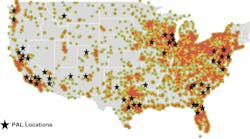“Overloading a vehicle is one of the worst things that happens in our industry,” said Weichman, director of fleet operations for Palm Beach County, Fla., while speaking at this week’s National Truck Equipment Assn. Convention. “You have to make sure the specs you put together can handle the loads that will be put on the vehicle in the field. If you don’t, an issue like this will come out in an accident situation – where liability can become a big problem.”
Weichman explained that one of the best ways fleet managers can avoid overloading is to use what he calls the “10% rule.” When selecting a vehicle, purchase one that – when fully loaded – is at or below 90% of its gross vehicle weight rating (GVWR).
That means when the vehicle’s chassis weight, body and accessories, full load of fuel, full passenger complement, and full load are combined, it only uses up 90% of the available GVWR. Though having that 10% of unused capacity can add to the cost of the initial purchase, a fleet should save money over the life of the vehicle, as running at or below 90% capacity cuts down on maintenance costs, said Weichman.
“You save a lot of money on brake repairs, tires, driveline work, and other maintenance over the vehicle’s life by NOT operating at the top edge of its GVWR,” he said. “From my perspective, it’s worth it.”


